Sage Thrashers
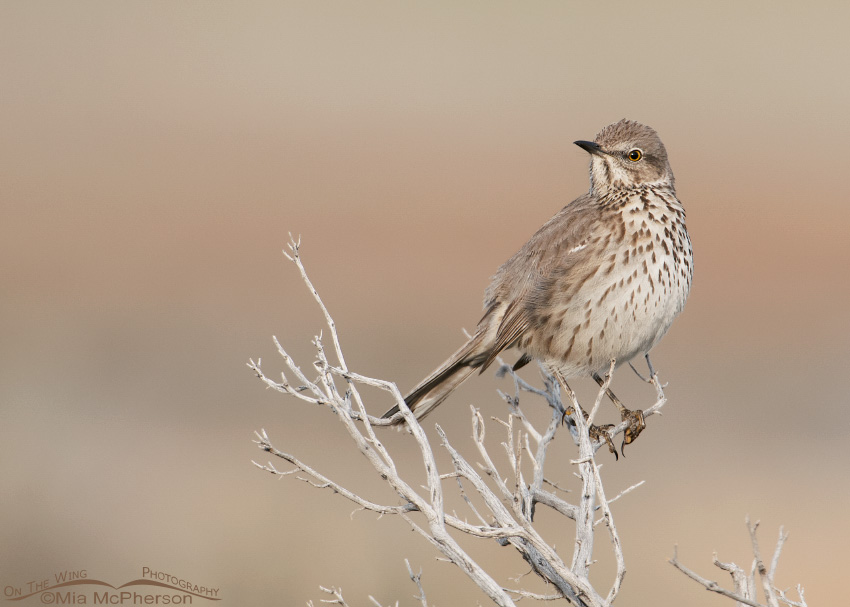 Sage Thrasher in golden light
Sage Thrasher in golden light
Sagebrush steppes are rapidly disappearing because of habitat destruction, invasive species and fires and if climate change continues the sea of sage that used to cover much of the western United States will disappear and Sagebrush-Obligate species like this Sage Thrasher will disappear too.
 Early spring Sage Thrasher
Early spring Sage Thrasher
So what does Sagebrush-Obligate mean? It means those species of birds and animals depend on Sagebrush to live and survive. You won’t see a Sage Thrasher during the breeding season in any location without sagebrush.
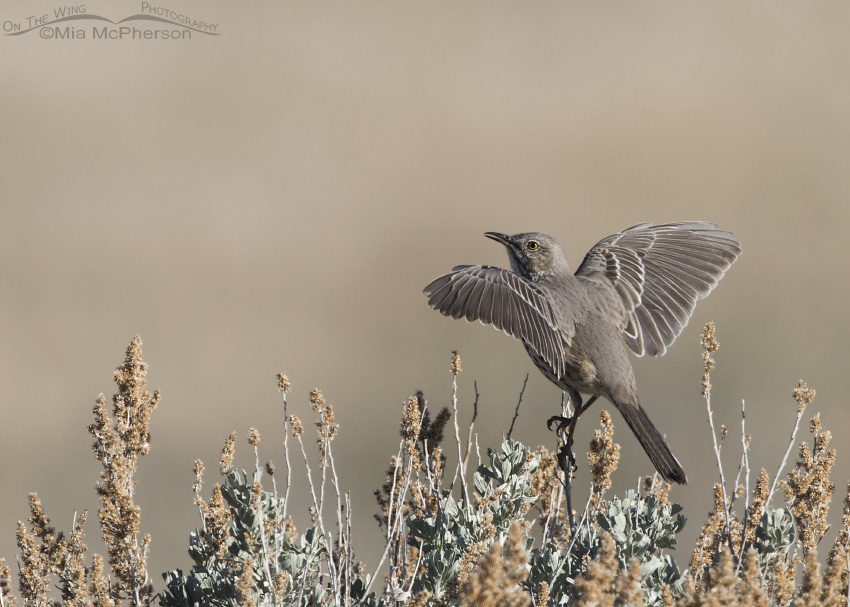 Sage Thrasher displaying
Sage Thrasher displaying
Habitat destruction includes clearing the land for cattle grazing. I’ve seen that happen on the gentle slopes of the Stansbury Mountain range and I honestly cringe when I see the land stripped of the sage which can allow invasive species like cheat grass to take hold. I see them ripping the sagebrush out of the ground during the nesting season and I know that eggs were destroyed and young birds were killed.
The Sage Thrashers won’t sing or display in those areas again in my lifetime.
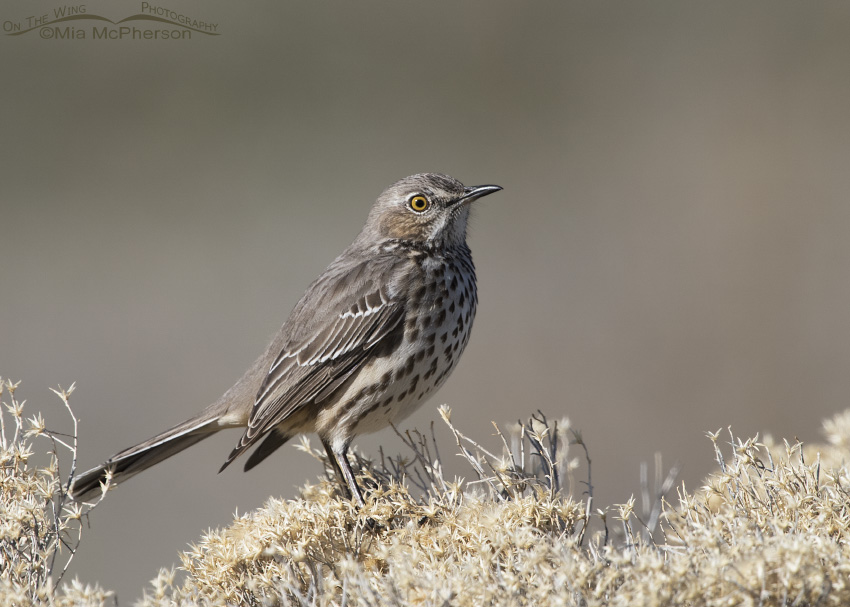 Dried Rabbitbrush and a Sage Thrasher
Dried Rabbitbrush and a Sage Thrasher
Climate change is going to cause huge problems for Sage Thrashers and other Sagebrush-Obligate species. I haven’t researched what the projections are for other Sagebrush-Obligate population declines but for the Sage Thrashers the projected population decline is 78%. That is right, 78% fewer Sage Thrashers than we have now and their populations have been declining about 0.6 percent per year since 1968.
Yes, I know that some people look at Sagebrush Steppes and think they are barren, worthless areas except for what can be extracted from the earth below.
They are wrong and ignorant.
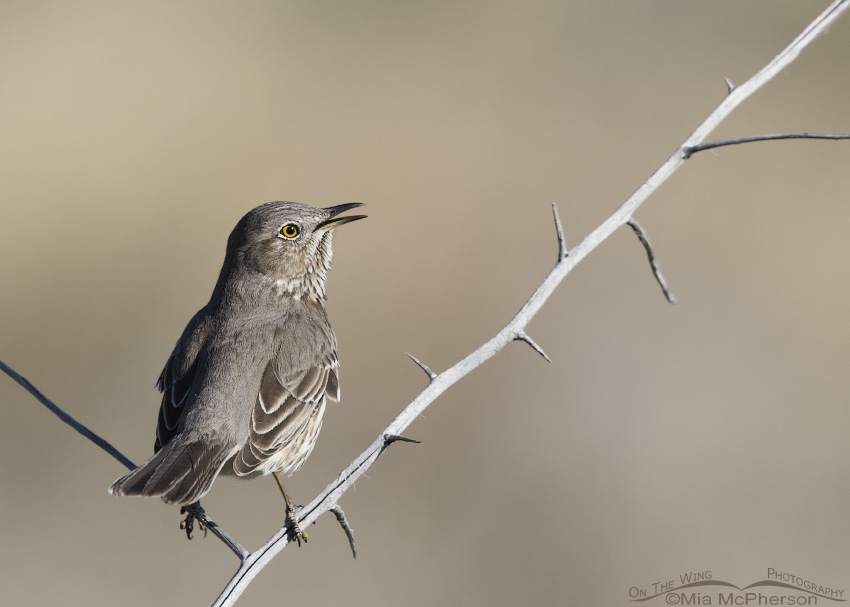 Singing Sage Thrasher
Singing Sage Thrasher
Ignorance about climate change is rampant, the Governor of Florida has put a law into effect that prevents state employees from even saying the words “climate change”. Well he might be able to stop those employees from saying those words but he isn’t going to stop what is already happening.
I have no doubt that our climate is changing because I see it every time I go into the field. Our winter was the warmest on record and it is just going to get worse in coming years. I’m dreading the high temps we will have this summer and the wildfires that will come along with them.
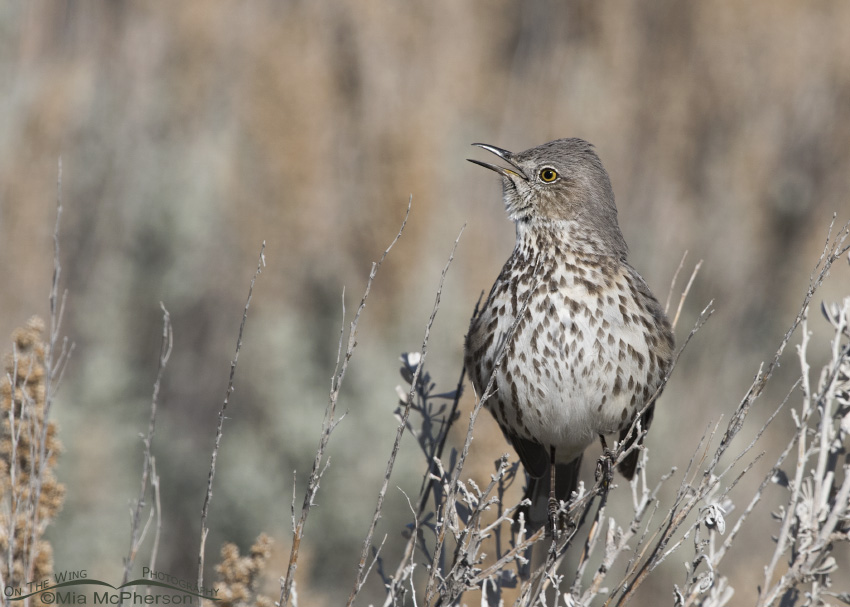 Sage Thrasher singing in the sage
Sage Thrasher singing in the sage
Sagebrush is slow growing so when it is yanked up to “improve” the area for cattle grazing or wildfires sweep through it takes decades to fully recover. And the Sagebrush-Obligate species have to move to other areas or die.
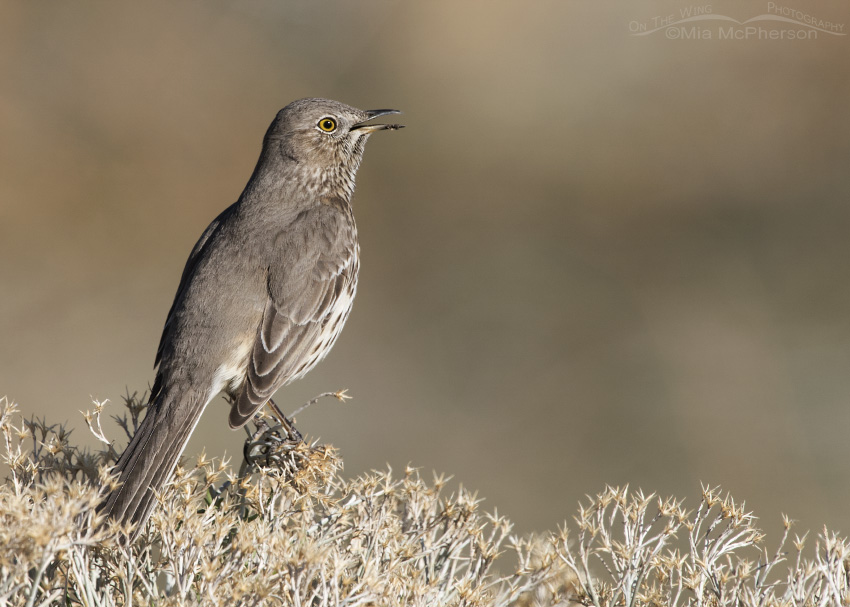 Antelope Island State Park Sage Thrasher
Antelope Island State Park Sage Thrasher
I probably won’t be around when the Sage Thrasher population reaches that projected 78% decline but my grandchildren and their children will be.
And I find that very sad.
Can the disappearance of Sagebrush Seas be stopped? Yes, it could be (or at least slowed down) but we need lawmakers that believe in science and act on it. We need lawmakers who care about future generations and the wildlife that inhabits our lands now. We need the people who care to step up now.
Tomorrow may be too late to help Sage Thrashers and the rapidly disappearing sea of sage.
Mia
Click here to see more of my Sage Thrasher photos plus facts and information about this species.
The first image in this post was taken last year using my Nikon D300 and Nikkor 200-400mm VR lens. The rest of the images were taken within this past week using my Nikon D810 with a Nikkor 500mm VR lens.


Beautiful series, and thoughts of hope for sage thrashers and sage populations !
Saddened by this, always a loss to lose birds.Will they just go to a different region or die off, I wonder? I met a rancher once who said that over-grazing caused the sage to grow on her fields-before that were native grasses that they were trying to bring back.I read Elephant’s Child’s comments and agree re our PM He designates land for wilderness but allows oil industry next to it-hello?
Hiss and spit.
Sadly the attitude that money now. ‘convenience’ now, and the thought that it is all about us is prevalent here too. Our current Prime Minister once said ‘climate change is crap’, and his actions support that statement.
How I wish that more people could look to the future and accept that it isn’t (or shouldn’t be) all about us…
EC, I don’t know how people can ignore the fact that our climate is changing. I saw a person just today say this about melting polar ice:
“where did the ice go? It just doesn’t “disappear”.”
Really? They don’t know? Ocean levels are rising and they don’t know?
Ostriches.
Beautiful images with interesting poses, and great perches and backgrounds.
Thanks so much Dave!
I don’t understand how that moron Governor in Florida can do that when our constituion guarantees FREEDOM OF SPEECH…Isn”t that not only ignorant and stupid, but unconstitutional???
Patty, it should be unconstitutional. It is ignorant.
Yes, “Ranchers need to make a living”…unfortunately, they “make a living” raising beef, the consumtion of which raises the rate of heart attacks” and often at the expense of the public by using (and abusing–ex. “Chaining”) PUBLIC lands…
Good point Patty. Scientists say they have found that fats and cholesterol are not the main reason why red meat increases susceptibility to heart disease. According to scientists, a substance in red meat called L-carnitine is linked to the risk of heart disease.
In the study published online in the journal Nature on April 7, 2013, titled: “Intestinal microbiota metabolism of L-carnitine, a nutrient in red meat, promotes atherosclerosis,” the researchers led by Dr. Stanely Hazen, head of preventive cardiology and chairman of the department of cellular and molecular medicine at the Lerner Research Institute of the Cleveland Clinic, found that the high incidence of heart disease among red meat eaters may be due to a relatively obscure substance called L-carnitine that helps transport fatty acids into the cell’s mitochondria where energy is produced.
Thanks for making that point Utahbooklover.
You’re welcome Mia. Wonderful post, both info and images. More on the red meat study:
http://www.digitaljournal.com/article/347522#ixzz2QPID3egP
Patty, Ranchers don’t have to make a living on public lands but they do and they pay a mere pittance for the privilege. Think of Bundy in Nevada who hasn’t paid his bill to US and the U.S..
Beautiful shots Mia. I totally agree with you on the value of leaving some of the sage habitats intact just for wildlife. Ranchers have to make a living too but it will be a sad day when it is difficult to find a sage thrasher or sage grouse. Some areas and species are just too fragile to postpone protection. Once they are gone it is very difficult if not impossible to restore. The battle is waging in East Canyon for a proposed development that will provide a resort and projected millions for a few but at the potential destruction of 2 sage grouse leks that have been there for centuries. Let’s hope the birds and wildlife can win one!
Larry, for now that resort/residential area has been voted down. Let’s hope it stays that way and that the lek is preserved for generations to come.
Very interesting, Mia, and sad. So much ignorance out there about the importance of preserving habitats. It’s interesting that you mention wildfires as a threat to sagebrush habitats. In Florida, as I’m sure you know, we have the opposite problem. Many of our precious habitats are shrinking because we put out fires. Our pine flatwood and scrub habitats are shrinking as they get taken over by hardwoods because without fires, they can encroach upon those habitats. It’s infuriating to think we may not figure out the cost of our actions until it’s too late.
Scott, wildfire suppression is an issue out here too, not so much in the sagebrush steppe though. I hope that future generations will put aside political differences and work towards a healthier world, towards saving habitat and reducing consumption. Hopefully they will be kinder towards our planet.